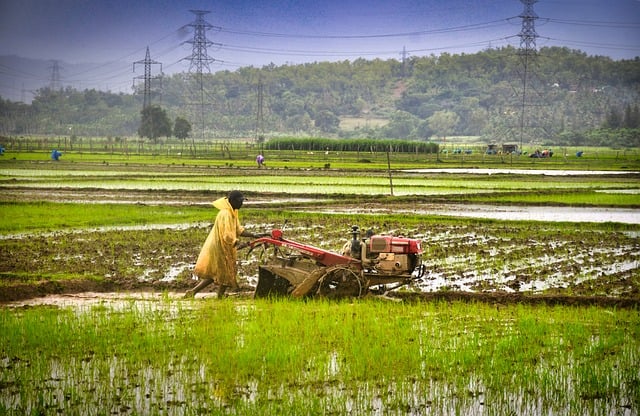Agriculture is the major contributor to South Asia’s GDP and is the backbone of its economy. About 60% of the population is employed in agriculture, further informing of the importance of agriculture in the region. However, there are multiple challenges, which include natural disasters, diminishing resources, rapid climate change, and most importantly – a large section of the youth population who are moving away from agriculture. To counter these issues, innovation & development must be practiced in the agricultural sector. This article aims to explore the solution to the aforementioned challenges with a focus on regional cooperation, policy development, and technological innovation.
Technological Innovation and Youth-Led Innovations
Through the adoption of farm mechanization, high-yielding varieties (HYV), and sustainable farming methods, South Asia has experienced progress in agricultural innovation & technology. For example, the success of Bhutan in integrating HYV of vegetables, rice, and maize increased crop production and benefited the cause of sustainable food security (DoA 2018). Using machinery like power tillers and combined harvesters has reduced the heavy dependency on labor and increased production efficiency manifolds in developing countries like Nepal and India (SAC, 2018).
Innovative practices such as powerhouse farming, drip irrigation, and organic farming is gaining traction. For instance, Bhutan adopted organic farming as a government policy, capitalizing on its traditional agricultural practices and reducing the use of chemicals, providing natural and nutritious food (Kobayashi et al., 2015). Using such practices ensures the sustainability of soil and water conservation and increases productivity and sustainable food security.
Youth-led initiatives are also leading the process of modernization in the agricultural sector across South Asia. Young entrepreneurs are utilizing modern tech to counter long-standing challenges and achieve climate resilience, market access, and sustainable agricultural practices. One example is in Bangladesh where iFarmer, a startup established by young entrepreneur Fahad Ifaz, connects the farmers directly with buying clients, this eliminates middlemen and ensures the farmers get just prices for their agricultural products (BRAC, 2023). Similarly, an app named Krisoker Janala was also created by young entrepreneurs to provide essential information for farmers regarding disease diagnosis, crop management, and weather forecasts (BRAC, 2023). These initiatives are now making farming not only easier but also more attractive for the younger generation.
The aquaponics and hydroponics methods are the areas where the youth are currently making significant progress. Tanvir Hossain, a Bangladeshi graduate embarrassed aquaponics – a method that combines fish farming with hydroponic agriculture (the use of water-based solutions to grow plants, replacing the reliance on the soil, and the use of pesticides). This innovation has allowed water conservation, and production of fresh produce to high-end markets, demonstrating the great potential for urban farming (BRAC, 2023). The shared examples identify the importance of youth-led innovation in the agricultural sector and the major developments the youth can make in this sector.
Institutional Support and Policy Framework
Efficient policy frameworks are essential in promoting innovation and development in agriculture. Bhutan’s Gross National Happiness (GNH) approach shows us the importance of sustained growth, with agriculture at the forefront of achieving rural development goals and sustainable food security (DoA, 2011). Bhutan prioritized research on agriculture in its 12th five-year plan, which focuses on organic farming and varieties of climate-resilient crops (ICIMOD, 2018).
Similar to Bhutan, India’s National Mission on Youth Agriculture aims to bring young people to the sector by providing them with skill development training, access to modern technologies, and entrepreneurship opportunities (TAAS, 2018). Such initiatives identify the need for constructive policy intervention that aligns with agricultural innovation with broader development goals. BRAC Bangladesh’s Youth-focused ‘Adaptation Clinics provides a one-stop service center, that includes climate-resilient technologies, market linkages, and advisory support, empowering young entrepreneurs, and reaching over 19,000 farmers nationwide (BRAC, 2023).
Knowledge Sharing and Regional Cooperation
Regional cooperation is essential in South Asia to address the common challenges to agriculture. For the facilitation of knowledge sharing and cross-border technology transfer, the SAART Agricultural Center (SAC) played an important role; for example, Bhutan benefited from germplasm and agriculture tech transfer with India, Nepal, and Bangladesh, which improved its crop productivity and diversity (SAC, 2018).
The establishment of a regional innovation platform, which the SAC proposed, can help accelerate the adoption of productivity-enhancing and climate-resilient technologies. Such platforms could enable farmers, researchers, and policymakers to cooperate, address region-specific challenges, and share best practices collectively (SAC, 2018).
The SAC proposed the establishment of a regional innovation platform that could further expedite the appropriation of climate-resilient and high-productivity technologies. The platform will also allow researchers, policymakers, and farmers to collaborate which will lead to further innovation & development (SAC, 2018). Additionally, the involvement of the youth in such platforms is critical, they will bring fresh perspectives, entrepreneurial energy, and digital expertise to the table.
Youth, the Change Agents in Agriculture
Youth-led agricultural transformation cannot be overstated. In Bangladesh, youth like Golam Nabi, who introduced the farming of dragon fruit, and Sabina Yeasmin, who struggled and created a successful dairy and goat farm, are examples of empowering the youth and driving them towards joining the agricultural sector (BRAC, 2023). In India, Sadat Rahman has transformed strawberry cultivation in the country’s Northern regions, again proving like Golam Nabi that non-traditional crops can thrive with innovation and proper care (BRAC, 2023). The stories of young innovators underscore the potential of youth entrepreneurship and youth-led initiatives can not only modernize but also make the agricultural sector more resilient to market fluctuations and rapid climate change.
Conclusion
It is critical for innovation in agriculture to tackle the various challenges faced in South Asia. Development in technology, aided by robust policy frameworks and regional cooperation, can ensure the agricultural sector’s productivity and sustainability and be more youth-friendly. By promoting and practicing environmentally conducive innovation, South Asia can achieve rural prosperity, food security, and environmental sustainability. For a successful transformation, the involvement of the youth needs to be ensured. The government and institutions must continue to support the empower the youth to ensure the sustainable future of agriculture in the region.
References
- Department of Agriculture (DoA). 2011. Renewable Natural Resources Research Policy of Bhutan, 2011. Thimphu: Ministry of Agriculture and Forests.
- DoA. 2018. Inventory of Released and De-notified Crops in Bhutan. Thimphu: Ministry of Agriculture and Forests.
- International Center for Integrated Mountain Development (ICIMOD). 2018. Organic Agriculture Development Strategies: Roadmap for 12th Five-Year Plan and Beyond. Kathmandu: ICIMOD.
- Kobayashi, M., R. Chhetri, and K. Fukamachi. 2015. “Transition of Agriculture Towards Organic Farming in Bhutan.” Himalayan Studies Monographs 16: 66–72.
- SAARC Agriculture Centre (SAC). 2018. SAARC Agriculture Centre Vision 2020. Dhaka: SAC.
- Trust for Advancement of Agricultural Sciences (TAAS). 2018. Strategy Paper on Motivating and Attracting Youth in Agriculture. New Delhi: TAAS.
- BRAC. 2023. Youth in Agriculture Transformation: A Case Story from Bangladesh. Dhaka: BRAC.






